Snow White and the Seven Dwarfs: Full Text Story, Video in English Version, Life Lessons
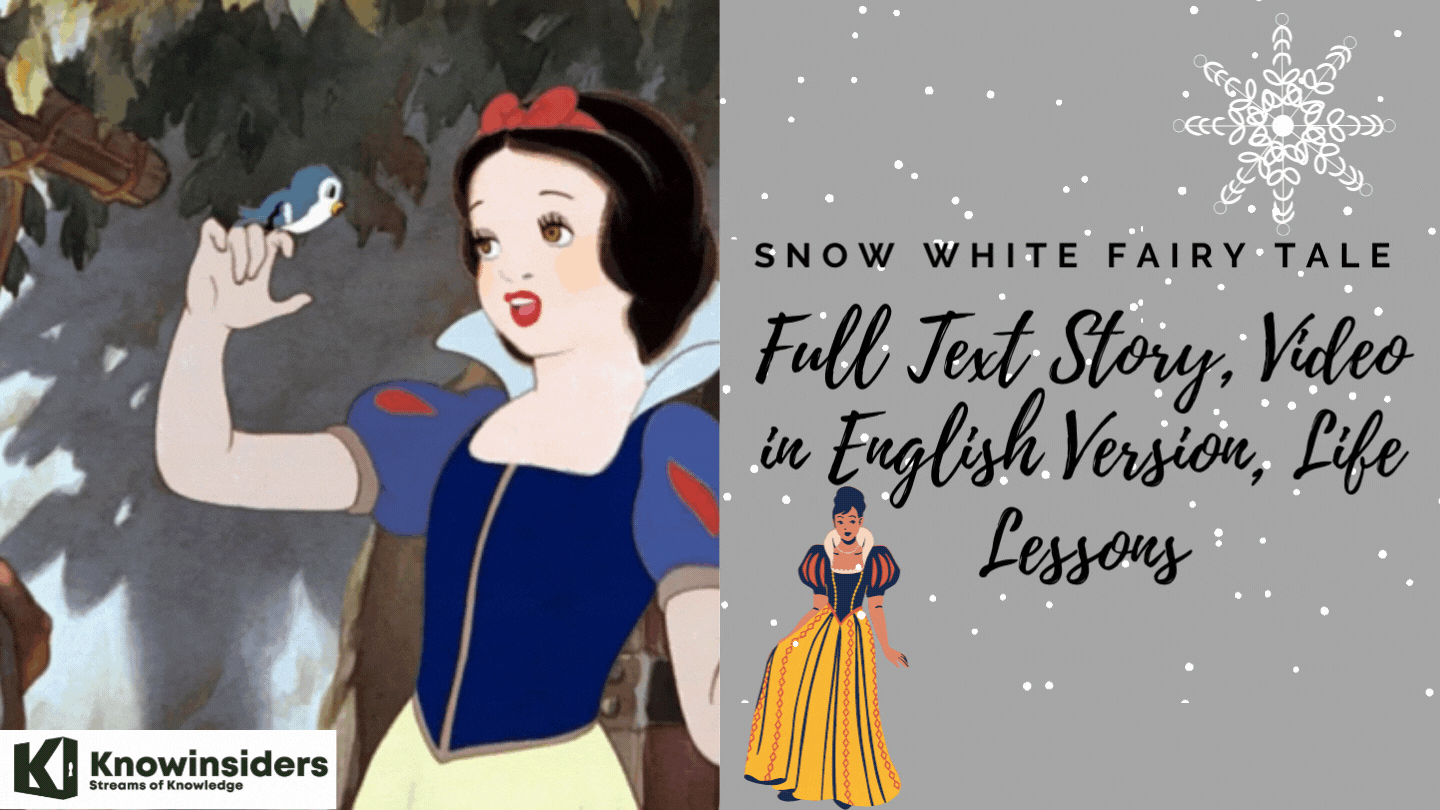 |
| Snow White and the Seven Dwarfs: Full Text Story, Video in English Version, Life Lessons |
"Snow White" is an 18th-century German fairy tale that is today known widely across the Western world. The Brothers Grimm published it in 1812 in the first edition of their collection Grimms' Fairy Tales and numbered as Tale 53. The original German title was Sneewittchen, a Low German form, but the first version gave the High German translation Schneeweißchen, and the tale has become known in German by the mixed form Schneewittchen. The Grimms completed their final revision of the story in 1854.
The fairy tale features such elements as the magic mirror, the poisoned apple, the glass coffin, and the characters of the Evil Queen and the Seven Dwarfs. The seven dwarfs were first given individual names in the 1912 Broadway play Snow White and the Seven Dwarfs and then given different names in Walt Disney's 1937 film Snow White and the Seven Dwarfs. The Grimm story, which is commonly referred to as "Snow White", should not be confused with the story of "Snow-White and Rose-Red" (in German "Schneeweißchen und Rosenrot"), another fairy tale collected by the Brothers Grimm.
In the Aarne–Thompson folklore classification, tales of this kind are grouped together as type 709, Snow White. Others of this kind include "Bella Venezia", "Myrsina", "Nourie Hadig", "Gold-Tree and Silver-Tree", "The Young Slave", and "La petite Toute-Belle".
Snow White: Video In English Version
What is the original story of Snow White?
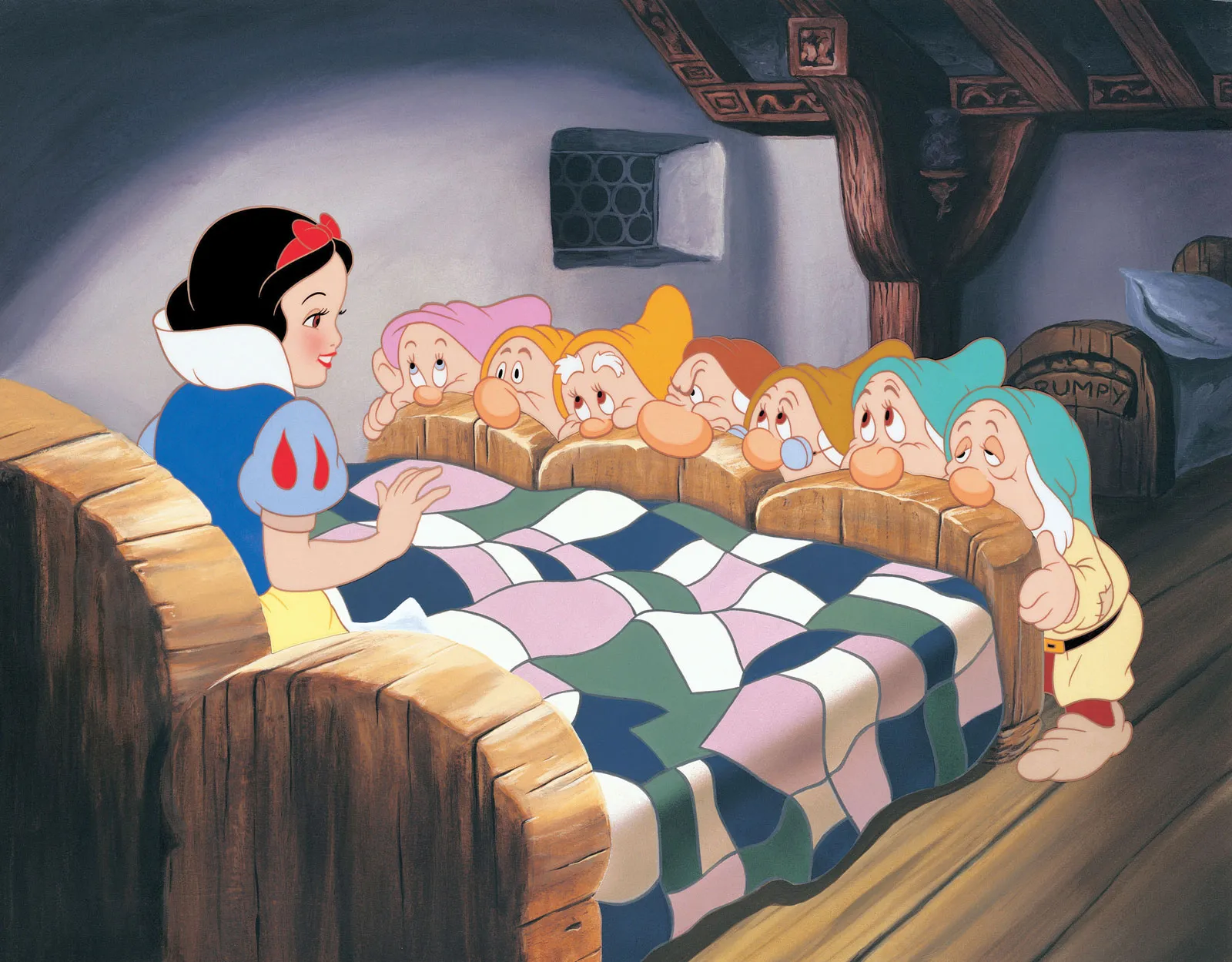 |
| Photo: Disney |
The original story of Snow White is taken from a 19th-century German fairy tale or folk tale, written by the Brothers Grimm. The German brothers known for their various folk tales and stories, published ‘Grimm’s Fairy Tales’ in 1812, which features the tale of Snow White as story number 53. Since its publication, the book has seen several of the original stories resonate to be enjoyed in popular culture up to his very day.
Other stories written by Brothers Grimm include Cinderella, Rumplestiltskin, Sleeping Beauty and 1812.
The Brothers Grimm Fairy Tales are universally acknowledged as the inspiration for the fairy tales we enjoy in book and film today. With various versions including film and pantomime, the modern day versions differ from Grimm’s tales slightly. Mainly, the modern day fairy stories are less dark then the originals, which involved more ‘grim’ themes.
What is Snow White Based on?
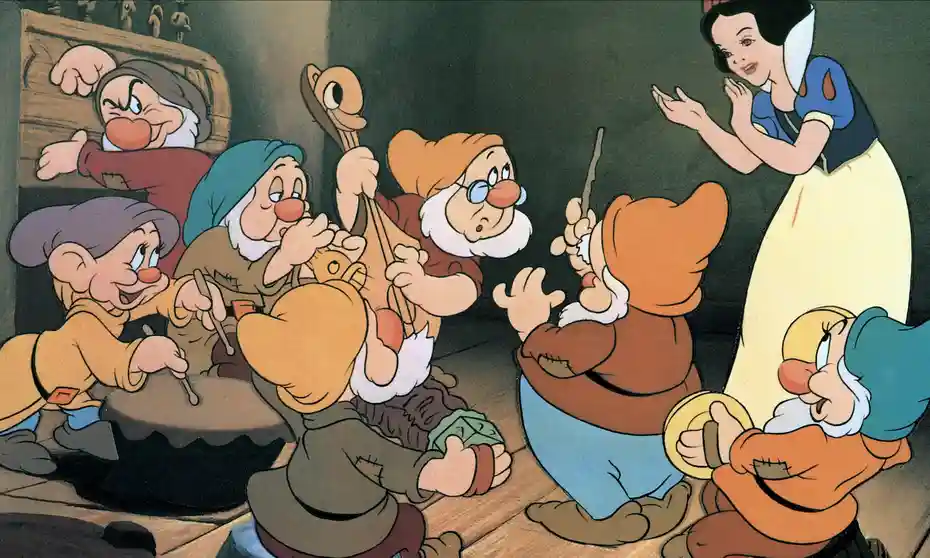 |
| Photo: Disney |
There has also been the suggestion that the story of Snow White originated from the real-life story of a countess and her alleged lover, Philip II of Spain.
The countess, named Margarete von Waldeck (1553 – 1554) was supposedly poisoned at a young age, as politics were more important than real love at the time. Another coincidence – Margarete had a terrible relationship with her stepmother.
Meanwhile, the town the countess grew up in, Wildungen, was also home to a number of copper mines. The workers of whom were young children, who suffered stunted growth due to malnutrition and poor working conditions. Allegedly, they were referred to as ‘poor dwarfs’.
These findings were published in 1994 by German Scholar Eckhard Sander, who’s book Schneewittchen: Marchen oder Wahrheit? (Snow White: Is It a Fairy Tale?) noted these comparisons.
An alternative account - Maria Sophia von Erthal
Not everyone is convinced by Sander’s claim that Snow White’s character stems from the life of Margarete von Waldeck. According to a study group in Lohr, Bavaria, Snow White is based on Maria Sophia von Erthal, born on June 15, 1729 in Lohr am Main, Bavaria. She was the daughter of 18th century landowner, Prince Philipp Christoph von Erthal and his wife, Baroness von Bettendorff.
After the death of the Baroness, Prince Philipp went onto marry Claudia Elisabeth Maria von Venningen, Countess of Reichenstein, who was said to dislike her stepchildren. The castle where they lived, now a museum, was home to a ‘talking mirror’, an acoustical toy that could speak (now housed in the Spessart Museum). The mirror, constructed in 1720 by the Mirror Manufacture of the Electorate of Mainz in Lohr, had been in the house during the time that Maria’s stepmother lived there.
The dwarfs in Maria’s story are also linked to a mining town, Bieber, located just west of Lohr and set among seven mountains. The smallest tunnels could only be accessed by very short miners, who often wore bright hoods, as the dwarfs have frequently been depicted over the years.
The Lohr study group maintain that the glass coffin may be linked to the region’s famous glassworks, while the poisoned apple, may be associated with the deadly nightshade poison that grows in abundance in Lohr.
It may never be known where the story of Snow White and the Seven Dwarfs truly originated as Grimm’s fairy tales were often an amalgamation of events that really occurred, mixed in with fantasy and imagination. Still, there is little doubt that there was at least some historical basis to the famous fairy tale .
Plot Summary
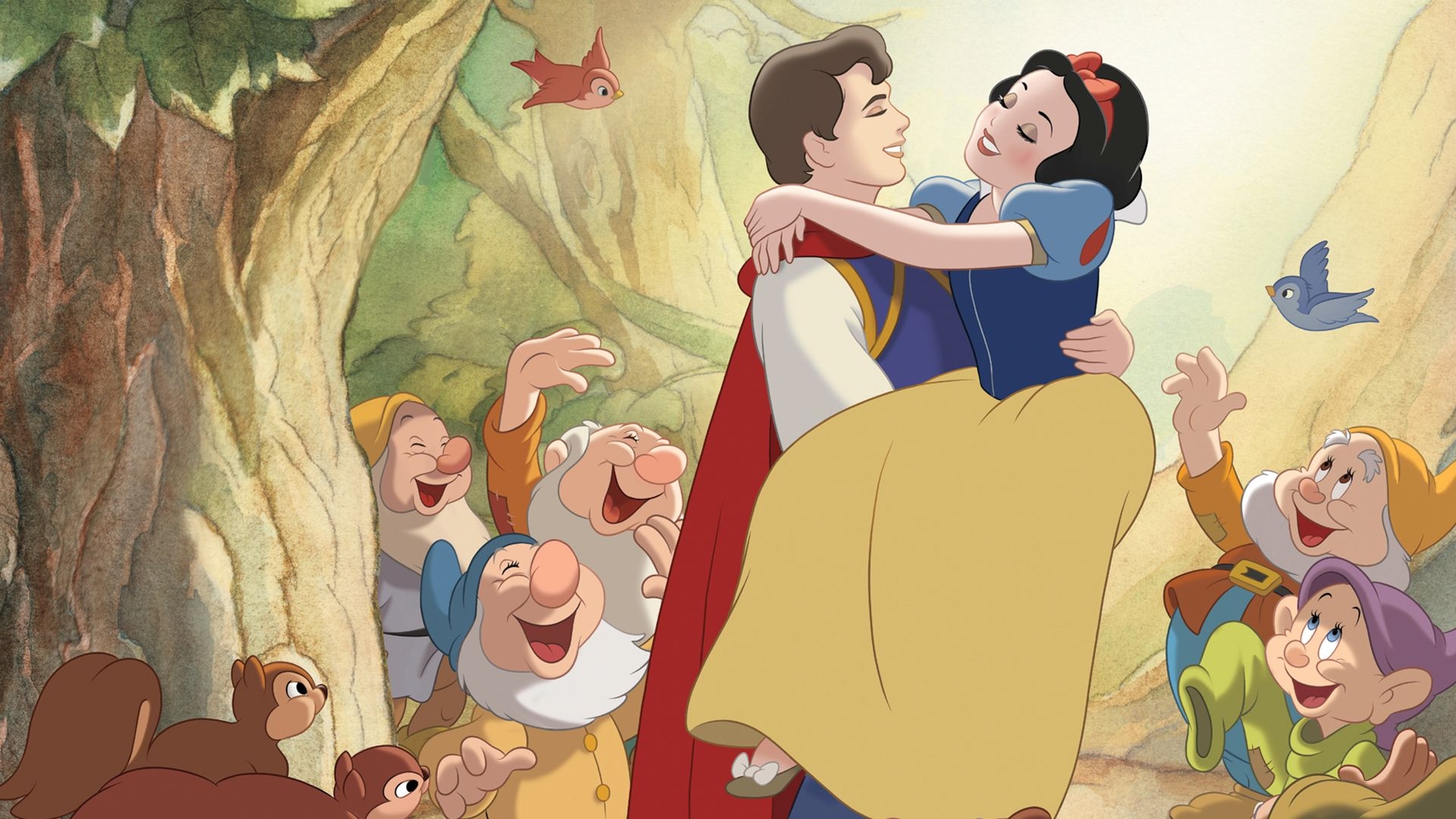 |
| Photo: What's On Disney Plus |
The story of Snow White and the Seven Dwarfs tells the tale of a beautiful princess born with skin so fair and pure that her mother named her Snow White. After the Queen’s death, her father married a woman who was vain and wicked, and who would stand in front of a magic mirror asking who was the fairest woman in the land. The mirror always replied, “My Queen, you are the fairest one of all”, until one day an answer came that threw her into a rage – Snow White was now the fairest woman in all the land.
Snow White’s step-mother, furious at what the mirror had told her, ordered a huntsman to take her into the forest and kill her. But the huntsman felt sympathy for Snow White and let her free. Snow White came upon a small cottage and, feeling exhausted, collapsed into one of the beds and fell into a deep sleep. When she awoke, seven dwarfs were looking down upon her. They told Snow White she could stay with them as long as she cleaned and cooked.
Snow White and the dwarfs lived in contentment until one day when the magic mirror told the Queen that Snow White was alive and was still the fairest of them all. The Queen disguised herself as an old woman and presented Snow White with a poisoned apple. After taking a bite of the apple, Snow White fell unconscious. The dwarfs, assuming she was dead, built a glass coffin and placed her inside.
One day, a handsome Prince passed by and saw Snow White in the coffin. He fell instantly in love with her and convinced the dwarfs to let him take the coffin so he could give her a proper funeral. As he and some other men were carrying the coffin, they tripped over some tree roots causing the poisoned apple to dislodge from Snow White’s throat. She awakened and the Prince declared his love for her. They were married, and as all fairy tales go, they lived happily ever after.
What characters were included Grimm’s, Snow White?
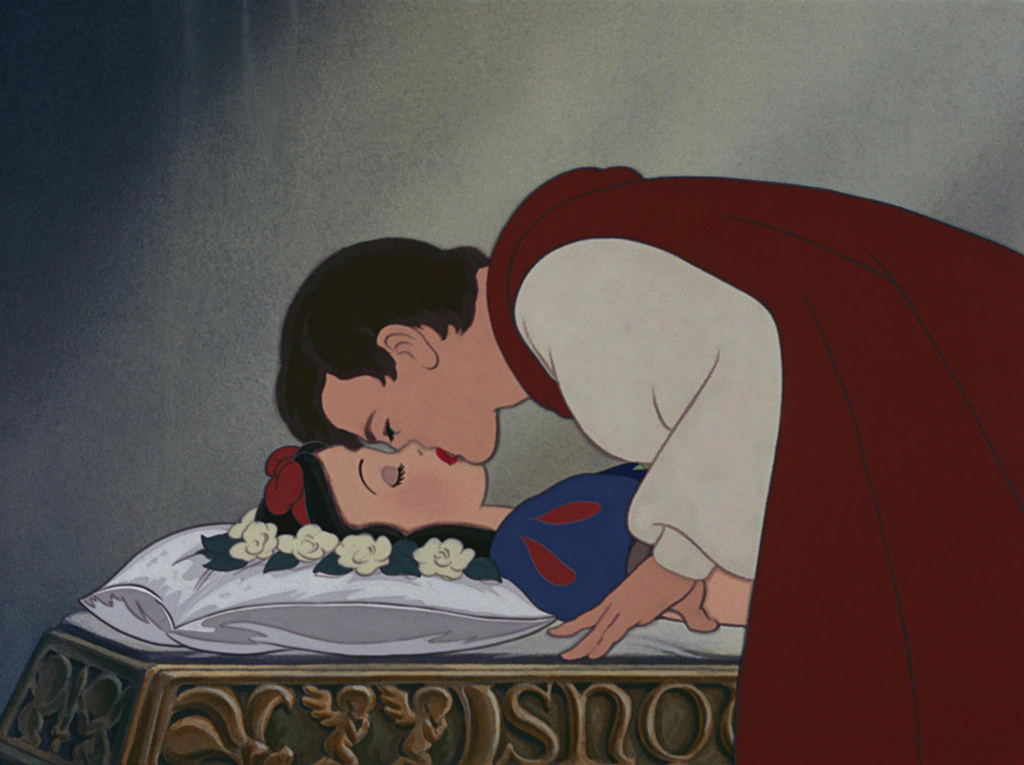 |
| Photo: Disney |
Snow White
The Prince
The Evil Queen
King
Huntsman
The Seven Dwarfs
One main difference, however, was that the dwarves were not actually given names until a 1912 Broadway production. This idea seemingly inspired the one and only Walt Disney, who gave the dwarves different names in his 1937 animated feature film ‘Snow White and the Seven Dwarfs.’
Of course, in modern day, many of us associate these stories with either the storybooks we were read as a child or otherwise, the animated Disney classics that have stood the test of time.
Arguably the most well-known Disney animated fairy tale is Snow White.
Snow White and the Seven Dwarfs: Full Text Story For Your Kids
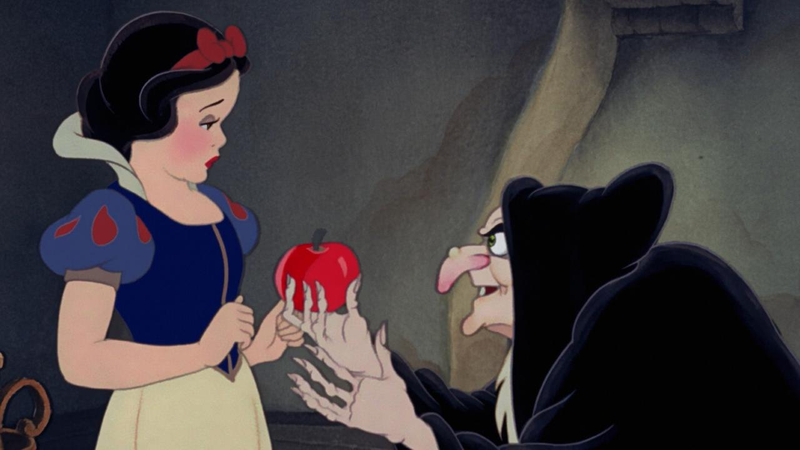 |
| Photo: MUBI |
Once upon a time in the middle of winter, when the flakes of snow were falling like feathers from the clouds, a Queen sat at her palace window, which had an ebony black frame, stitching her husband’s shirts. While she was thus engaged and looking out at the snow she pricked her finger, and three drops of blood fell upon the snow. Now the red looked so well upon the white that she thought to herself, “Oh, that I had a child as white as this snow, as red as this blood, and as black as the wood of this frame!” Soon afterwards a little daughter came to her, who was as white as snow, and with cheeks as red as blood, and with hair as black as ebony, and from this she was named “Snow-White.” And at the same time her mother died.
About a year afterwards the King married another wife, who was very beautiful, but so proud and haughty that she could not bear anyone to be better-looking than herself. She owned a wonderful mirror, and when she stepped before it and said:
“Mirror, mirror on the wall,
Who is the fairest of us all?”
it replied:
“The Queen is the fairest of the day.”
Then she was pleased, for she knew that the mirror spoke truly.
Little Snow-White, however, grew up, and became prettier and prettier, and when she was seven years old she was as fair as the noonday, and more beautiful than the Queen herself. When the Queen now asked her mirror:
“Mirror, mirror on the wall,
Who is the fairest of us all?”
it replied:
“The Queen was fairest yesterday;
Snow-White is the fairest, now, they say.”
This answer so angered the Queen that she became quite yellow with envy. From that hour, whenever she saw Snow-White, her heart was hardened against her, and she hated the little girl. Her envy and jealousy increased so that she had no rest day or night, and she said to a Huntsman, “Take the child away into the forest. I will never look upon her again. You must kill her, and bring me her heart and tongue for a token.”
The Huntsman listened and took the maiden away, but when he drew out his knife to kill her, she began to cry, saying, “Ah, dear Huntsman, give me my life! I will run into the wild forest, and never come home again.”
This speech softened the Hunter’s heart, and her beauty so touched him that he had pity on her and said, “Well, run away then, poor child.” But he thought to himself, “The wild beasts will soon devour you.” Still he felt as if a stone had been lifted from his heart, because her death was not by his hand. Just at that moment a young boar came roaring along to the spot, and as soon as he clapped eyes upon it the Huntsman caught it, and, killing it, took its tongue and heart and carried them to the Queen, for a token of his deed.
But now poor little Snow-White was left motherless and alone, and overcome with grief, she was bewildered at the sight of so many trees, and knew not which way to turn. She ran till her feet refused to go farther, and as it was getting dark, and she saw a little house near, she entered in to rest. In this cottage everything was very small, but very neat and elegant. In the middle stood a little table with a white cloth over it, and seven little plates upon it, each plate having a spoon and a knife and a fork, and there were also seven little mugs. Against the wall were seven little beds arranged in a row, each covered with snow-white sheets.
Little Snow-White, being both hungry and thirsty, ate a little morsel of porridge out of each plate, and drank a drop or two of wine out of each mug, for she did not wish to take away the whole share of anyone. After that, because she was so tired, she laid herself down on one bed, but it did not suit; she tried another, but that was too long; a fourth was too short, a fifth too hard. But the seventh was just the thing; and tucking herself up in it, she went to sleep, first saying her prayers as usual.
When it became quite dark the owners of the cottage came home, seven Dwarfs, who dug for gold and silver in the mountains. They first lighted seven little lamps, and saw at once—for they lit up the whole room—that somebody had been in, for everything was not in the order in which they had left it.
The first asked, “Who has been sitting on my chair?” The second, “Who has been eating off my plate?” The third said, “Who has been nibbling at my bread?” The fourth, “Who has been at my porridge?” The fifth, “Who has been meddling with my fork?” The sixth grumbled out, “Who has been cutting with my knife?” The seventh said, “Who has been drinking out of my mug?”
Then the first, looking round, began again, “Who has been lying on my bed?” he asked, for he saw that the sheets were tumbled. At these words the others came, and looking at their beds cried out too, “Some one has been lying in our beds!” But the seventh little man, running up to his, saw Snow-White sleeping in it; so he called his companions, who shouted with wonder and held up their seven lamps, so that the light fell upon the little girl.
“Oh, heavens! oh, heavens!” said they; “what a beauty she is!” and they were so much delighted that they would not awaken her, but left her to sleep, and the seventh Dwarf, in whose bed she was, slept with each of his fellows one hour, and so passed the night.
As soon as morning dawned Snow-White awoke, and was quite frightened when she saw the seven little men; but they were very friendly, and asked her what she was called.
“My name is Snow-White,” was her reply.
“Why have you come into our cottage?” they asked.
Then she told them how her stepmother would have had her killed, but the Huntsman had spared her life, and how she had wandered about the Whole day until at last she had found their house.
When her tale was finished the Dwarfs said, “Will you look after our household—be our cook, make the beds, wash, sew, and knit for us, and keep everything in neat order? If so, we will keep you here, and you shall want for nothing.”
And Snow-White answered, “Yes, with all my heart and will.” And so she remained with them, and kept their house in order.
In the morning the Dwarfs went into the mountains and searched for silver and gold, and in the evening they came home and found their meals ready for them. During the day the maiden was left alone, and therefore the good Dwarfs warned her and said, “Be careful of your stepmother, who will soon know of your being here. So let nobody enter the cottage.”
The Queen meanwhile, supposing that she had eaten the heart and tongue of her stepdaughter, believed that she was now above all the most beautiful woman in the world. One day she stepped before her mirror, and said:
“Mirror, mirror on the wall,
Who is the fairest of us all?”
and it replied:
“The Queen was fairest yesterday;
Snow-White is fairest now, they say.
The Dwarfs protect her from thy sway
Amid the forest, far away.”
This reply surprised her, but she knew that the mirror spoke the truth. She knew, therefore, that the Huntsman had deceived her, and that Snow-White was still alive. So she dyed her face and clothed herself as a pedler woman, so that no one could recognize her, and in this disguise she went over the seven hills to the house of the seven Dwarfs. She knocked at the door of the hut, and called out, “Fine goods for sale! beautiful goods for sale!”
Snow-White peeped out of the window and said, “Good day, my good woman; what have you to sell?”
“Fine goods, beautiful goods!” she replied. “Stays of all colors.” And she held up a pair which were made of many-colored silks.
“I may let in this honest woman,” thought Snow-White; and she unbolted the door and bargained for one pair of stays.
“You can’t think, my dear, how they become you!” exclaimed the old woman. “Come, let me lace them up for you.”
Snow-White suspected nothing, and let her do as she wished, but the old woman laced her up so quickly and so tightly that all her breath went, and she fell down like one dead. “Now,” thought the old woman to herself, hastening away, “now am I once more the most beautiful of all!”
At eventide, not long after she had left, the seven Dwarfs came home, and were much frightened at seeing their dear little maid lying on the ground, and neither moving nor breathing, as if she were dead. They raised her up, and when they saw that she was laced too tight they cut the stays to pieces, and presently she began to breathe again, and little by little she revived. When the Dwarfs now heard what had taken place, they said, “The old pedler woman was no other than your wicked stepmother. Take more care of yourself, and let no one enter when we are not with you.”
Meanwhile, the Queen had reached home, and, going before her mirror, she repeated her usual words:
“Mirror, mirror on the wall,
Who is the fairest of us all?”
and it replied as before:
“The Queen was fairest yesterday;
Snow-White is fairest now, they say.
The Dwarfs protect her from thy sway
Amid the forest, far away.”
As soon as it had finished, all her blood rushed to her heart, for she was so angry to hear that Snow-White was yet living. “But now,” thought she to herself, “will I make something which shall destroy her completely.” Thus saying, she made a poisoned comb by arts which she understood, and then, disguising herself, she took the form of an old widow. She went over the seven hills to the house of the seven Dwarfs, and knocking at the door, called out, “Good wares to sell to-day!”
Snow-White peeped out and said, “You must go farther, for I dare not let you in.”
“But still you may look,” said the old woman, drawing out her poisoned comb and holding it up. The sight of this pleased the maiden so much that she allowed herself to be persuaded, and opened the door. As soon as she had bought something the old woman said, “Now let me for once comb your hair properly,” and Snow-White consented. But scarcely was the comb drawn through the hair when the poison began to work, and the maiden fell down senseless.
“You pattern of beauty,” cried the wicked Queen, “it is now all over with you.” And so saying, she departed.
Fortunately, evening soon came, and the seven Dwarfs returned, and as soon as they saw Snow-White lying, like dead, upon the ground, they suspected the Queen, and discovering the poisoned comb, they immediately drew it out. Then the maiden very soon revived and told them all that had happened. So again they warned her against the wicked stepmother, and bade her open the door to nobody.
Meanwhile the Queen, on her arrival home, had again consulted her mirror, and received the same answer as twice before. This made her tremble and foam with rage and jealousy, and she swore that Snow-White should die if it cost her her own life. Thereupon she went into an inner secret chamber where no one could enter, and made an apple of the most deep and subtle poison. Outwardly it looked nice enough, and had rosy cheeks which would make the mouth of everyone who looked at it water; but whoever ate the smallest piece of it would surely die. As soon as the apple was ready the Queen again dyed her face, and clothed herself like a peasant’s wife, and then over the seven mountains to the house of the seven Dwarfs she made her way.
She knocked at the door, and Snow-White stretched out her head and said, “I dare not let anyone enter; the seven Dwarfs have forbidden me.”
“That is hard on me,” said the old woman, “for I must take back my apples; but there is one which I will give you.”
“No,” answered Snow-White; “no, I dare not take it.”
“What! are you afraid of it?” cried the old woman. “There, see—I will cut the apple in halves; do you eat the red cheeks, and I will eat the core.” (The apple was so artfully made that the red cheeks alone were poisoned.) Snow-White very much wished for the beautiful apple, and when she saw the woman eating the core she could no longer resist, but, stretching out her hand, took the poisoned part. Scarcely had she placed a piece in her mouth when she fell down dead upon the ground. Then the Queen, looking at her with glittering eyes, and laughing bitterly, exclaimed, “White as snow, red as blood, black as ebony! This time the Dwarfs cannot reawaken you.”
When she reached home and consulted her mirror—
“Mirror, mirror on the wall,
Who is the fairest of us all?”
it answered:
“The Queen is fairest of the day.”
Then her envious heart was at rest, as peacefully as an envious heart can rest.
When the little Dwarfs returned home in the evening they found Snow-White lying on the ground, and there appeared to be no life in her body; she seemed to be quite dead. They raised her up, and tried if they could find anything poisonous. They unlaced her, and even uncombed her hair, and washed her with water and with wine. But nothing availed: the dear child was really and truly dead.
Then they laid her upon a bier, and all seven placed themselves around it, and wept and wept for three days without ceasing. Then they prepared to bury her. But she looked still fresh and life-like, and even her red cheeks had not deserted her, so they said to one another, “We cannot bury her in the black ground.” Then they ordered a case to be made of glass. In this they could see the body on all sides, and the Dwarfs wrote her name with golden letters upon the glass, saying that she was a King’s daughter. Now they placed the glass case upon the ledge on a rock, and one of them always remained by it watching. Even the birds bewailed the loss of Snow-White; first came an owl, then a raven, and last of all a dove.
For a long time Snow-White lay peacefully in her case, and changed not, but looked as if she were only asleep, for she was still white as snow, red as blood, and black-haired as ebony. By and by it happened that a King’s son was traveling in the forest, and came to the Dwarfs’ house to pass the night. He soon saw the glass case upon the rock, and the beautiful maiden lying within, and he read also the golden inscription.
When he had examined it, he said to the Dwarfs, “Let me have this case, and I will pay what you like for it.”
But the Dwarfs replied, “We will not sell it for all the gold in the world.”
“Then give it to me,” said the Prince; “for I cannot live without Snow-White. I will honor and protect her as long as I live.”
When the Dwarfs saw that he was so much in earnest, they pitied him, and at last gave him the case, and the Prince ordered it to be carried away on the shoulders of his attendants. Presently it happened that they stumbled over a rut, and with the shock the piece of poisoned apple which lay in Snow-White’s mouth fell out. Very soon she opened her eyes, and raising the lid of the glass case, she rose up and asked, “Where am I?”
Full of joy, the Prince answered, “You are safe with me.” And he told to her what she had suffered, and how he would rather have her than any other for his wife, and he asked her to accompany him home to the castle of the King his father. Snow-White consented, and when they arrived there they were married with great splendor and magnificence.
Snow-White’s stepmother was also invited to the wedding, and when she was dressed in all her finery to go, she first stepped in front of her mirror and asked:
“Mirror, mirror on the wall,
Who is the fairest of us all?”
and it replied:
“The Queen was fairest yesterday;
The Prince’s bride is now, they say.”
At these words the Queen was in a fury, and was so terribly mortified that she knew not what to do with herself. At first she resolved not to go to the wedding, but she could not resist the wish to see the Princess. So she went; but as soon as she saw the bride she recognized Snow-White, and was so terrified with rage and astonishment that she rushed out of the castle and was never heard of again.
Valuable lessons we can learn from 'Snow White'1. It's wonderful to have friends. When Snow White had nowhere else to go, she was welcomed in the humble abode of the seven dwarfs – Scrubber, Blubber, Scotty, Flubber, Pepito, Mosquito, and Fred. These little creatures embraced her like one of their own. 2. You can appeal to the goodness in everyone. When the Evil Queen ordered the woodsman to kill Snow White, he failed, not because he was incapable but because Snow White appealed to the goodness in him. Snow White believed that deep inside, the woodsman is capable of kindness. Snow White was right, there's goodness in each and every one of us. 3. Insecurities doesn't justify your mean attitude. Every time the queen asks the Magic Mirror, "Mirror, mirror on the wall, who is the fairest of them all?" and she gets her most dreaded answer, "Snow White," she goes into a deep rage. Everyone has insecurities. It's how they deal with it. The queen deals with it by being mean. In the end, the queen still failed because anything rooted in evil never wins. 4. Don't talk to strangers (and don't let them in your house). When the woodsman failed to kill Snow White, the queen decided to do it herself by disguising as an old woman. Despite the dwarfs' advice to her, Snow White's golden heart still prevailed. She talked to the old woman, accepted the apple she offered, and fell into a deep sleep. When in doubt, always remember what the dwarfs told Snow White, "Don't talk to strangers and don't let them in your house." It's better to be safe than sorry. 5. Real beauty comes from within. Driven by jealousy, the Evil Queen had to kill Snow White to become the "fairest of them all." But despite her many attempts, the queen never succeeded because the Magic Mirror recognizes Snow White's beauty — both on the outside and most importantly, from the inside. The queen was not and will never be as beautiful as Snow White not because she's less attractive but because her heart is not as pure. |
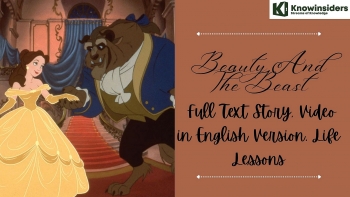 Beauty And The Beast FairyTale: Full Text Story, Video in English Version, Life Lessons Beauty And The Beast FairyTale: Full Text Story, Video in English Version, Life Lessons Reading or watching the best fairy tale of Beauty And The Beast: Here are the full-text story, beautiful pictures, and the best video in the ... |
 Little Red Riding Hood FairyTale: Full Text Story, Video in English Version and Life Lessons Little Red Riding Hood FairyTale: Full Text Story, Video in English Version and Life Lessons Reading or watching the best fairy tale of Little Red Riding Hood: Here are the full-text story, beautiful pictures, and the best video in the ... |
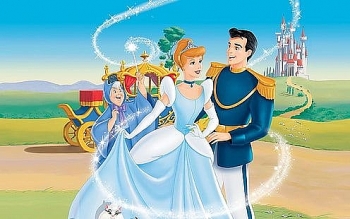 Cinderella FairyTale: Full Text Story, Video in English Version, Life Lessons Cinderella FairyTale: Full Text Story, Video in English Version, Life Lessons Reading or watching the best fairy tale of Cinderella (The Little Glass Slipper): Here are the full text story, beautiful pictures and best video in ... |
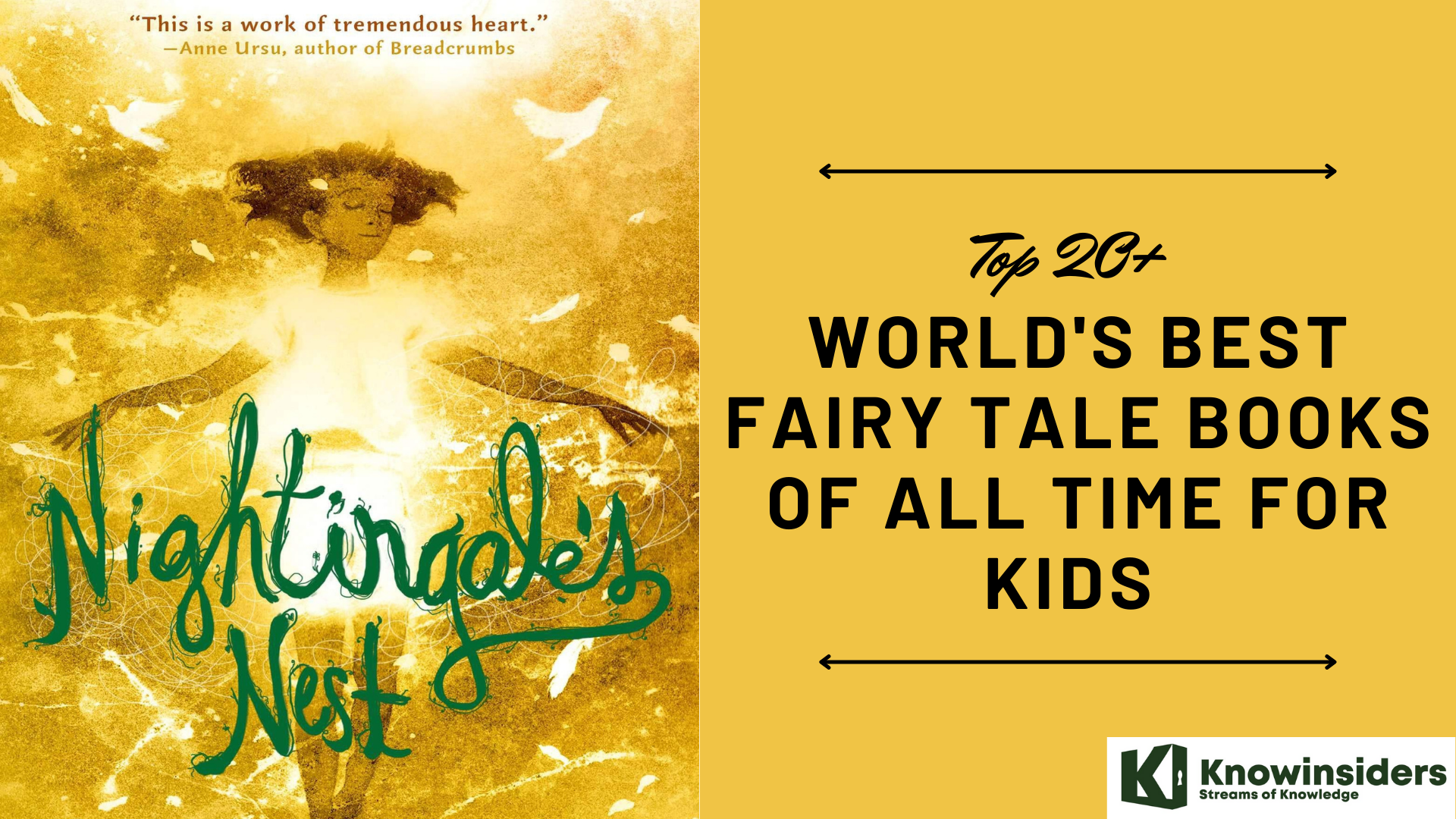 Top 20+ World's Best Fairy Tale Books Of All Time For Kids Top 20+ World's Best Fairy Tale Books Of All Time For Kids Fairy tale books are interesting, full of magic and wonderful moments, and valuable lessons for kids to learn from. Take a look at the list ... |


























